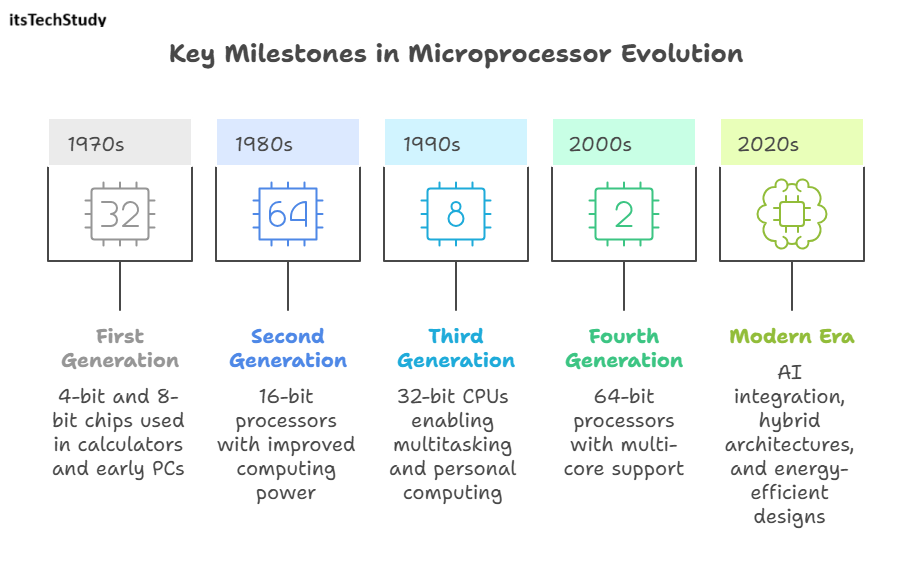Introduction: Why Microprocessors Matter More Than Ever
In the fast-changing world of technology, microprocessors remain at the core of innovation. These small but powerful chips fuel the performance of laptops, smartphones, gaming consoles, AI servers, and even smart appliances. Without them, our digital lives would come to a standstill.
But as demand for faster, smarter, and energy-efficient devices grows, the industry faces major challenges. Engineers are tasked with squeezing more performance into smaller chips while also reducing power consumption and ensuring cost efficiency. Add in the pressure of AI integration and advanced graphics, and the competition between industry leaders becomes even more intense.
This is where AMD and Intel take center stage. Both companies have introduced groundbreaking advancements in 2025 that are shaping the future of technology.
What Exactly Is a Microprocessor?
At its core, a microprocessor is a compact CPU (Central Processing Unit) housed in a single integrated circuit. It’s responsible for executing instructions, performing calculations, and coordinating communication between all parts of a computer system.
Key Features of Microprocessors:
- CPU on a Chip: Consolidates processing power into a single integrated unit.
- Instruction Execution: Handles arithmetic, logic, and control operations.
- Data Processing: Executes billions of calculations per second.
- Peripheral Communication: Interfaces with memory, storage, and input/output devices.

In short, it’s the “brain” that enables everything from browsing the web on your phone to training AI models in supercomputers.
The Evolution of Microprocessors
Microprocessors have advanced dramatically over the decades:
- 1970s – First Generation: 4-bit and 8-bit chips used in calculators and early PCs.
- 1980s – Second Generation: 16-bit processors with improved computing power.
- 1990s – Third Generation: 32-bit CPUs enabling multitasking and personal computing.
- 2000s – Fourth Generation: 64-bit processors with multi-core support.
- 2020s – Modern Era: AI integration, hybrid architectures, and energy-efficient designs.

By 2025, the focus has shifted toward AI-powered performance and green technology, with AMD and Intel leading the race.
AMD’s Big Move: Partnering with OpenAI
In 2025, AMD made headlines with a multi-year deal with OpenAI, marking a significant push into the AI hardware market.
Key Highlights of the Partnership:
- Instinct MI450 GPUs: Capable of delivering up to 1 gigawatt of processing power by late 2026, with plans to scale up to 6 gigawatts.
- Equity Stake Option: Open AI has the option to purchase up to 10% of AMD’s shares, depending on milestones such as chip delivery and market performance.
- Market Reaction: AMD’s stock price surged after the announcement, reflecting growing investor confidence.

Why it matters: This partnership not only strengthens AMD’s role in AI infrastructure but also puts pressure on competitors like Nvidia in the high-performance GPU space.
Intel’s Game-Changer: The Core Ultra 200 Series
At CES 2025, Intel unveiled its Core Ultra 200 Series processors, designed for modern computing needs ranging from gaming to industrial workloads.
Standout Features of Core Ultra 200 Series:
- Hybrid Architecture: Mixes Performance-cores with Efficient-cores for optimal speed and power balance.
- Built-in Neural Processing Unit (NPU): Accelerates AI tasks like real-time inference and edge computing.
- Intel Arc Graphics: Provides seamless performance for gaming and content creation with enhanced visuals.
Why it matters: Intel is focusing on versatility, making its processors suitable for laptops, desktops, and professional applications.
AMD vs Intel: A Quick Comparison
| Feature | AMD Instinct MI450 (with OpenAI) | Intel Core Ultra 200 Series |
|---|---|---|
| AI Integration | Advanced AI GPU capabilities | Integrated NPU for AI tasks |
| Performance Focus | High-performance GPUs | Hybrid CPU architecture |
| Target Applications | AI data centers | Mobile computing, gaming |
| Partnerships | OpenAI collaboration | Broad global adoption |
| Market Position | Emerging AI hardware leader | Established CPU leader |
Pros and Cons of AMD vs Intel Microprocessors
AMD Microprocessors – Pros
- Exceptional performance in AI workloads
- Strong GPU-driven innovations
- Strategic partnerships (e.g., OpenAI) boosting relevance
AMD Microprocessors – Cons
- Limited presence in mobile devices
- Reliance on key partnerships for growth
Intel Microprocessors – Pros
- Established leadership in laptops and PCs
- Versatile processors suitable for gaming, business, and creative use
- Strong industry adoption across markets
Intel Microprocessors – Cons
- Slower entry into AI-dedicated hardware
- Facing stiff competition in CPU and GPU segments
Conclusion: The Microprocessor Landscape in 2025
As we move further into 2025, the microprocessor industry is at a turning point. AMD is betting big on AI with its partnership with OpenAI, while Intel continues to refine versatile processors for mainstream and enterprise users.
The choice between AMD and Intel ultimately depends on your needs—whether it’s high-performance AI computing, reliable gaming, or everyday productivity. One thing is certain: with constant tech innovations, the future of microprocessors will be faster, smarter, and more energy-efficient than ever before.
FAQs About Microprocessors in 2025
Q1: What is the importance of AMD’s deal with OpenAI?
Ans: It secures AMD’s position in the AI data center market, providing powerful GPUs for machine learning and large-scale computations.
Q2: How are Intel’s new processors different from older models?
Ans: The Core Ultra 200 Series introduces hybrid cores and integrated AI acceleration, making them far more efficient and AI-ready compared to older CPUs.
Q3: Which processor is better for gaming – AMD or Intel?
Ans: Both perform well, but Intel’s integration of Arc Graphics gives it an edge for gamers, while AMD excels in heavy AI or GPU-intensive tasks.
Q4: Can AMD chips compete with Nvidia in AI?
Ans: Yes. With the Instinct MI450 GPUs, AMD is directly challenging Nvidia’s dominance in the AI accelerator market.
Q5: What factors should I consider when choosing a processor?
Ans: Look at use case (AI, gaming, business), power efficiency, core performance, and compatibility with your device or system.












No Comments Yet
Be the first to share your thoughts.
Leave a Comment